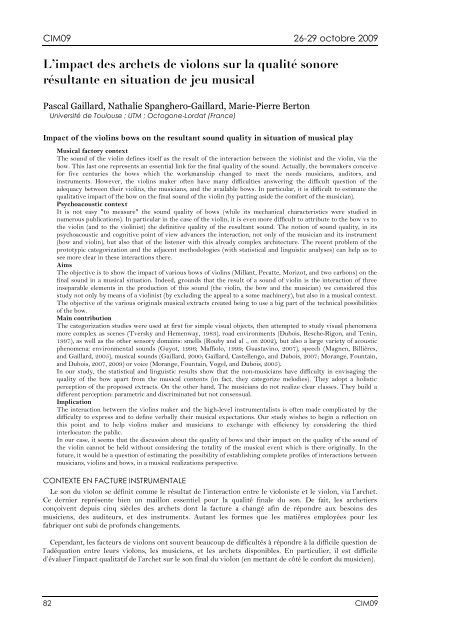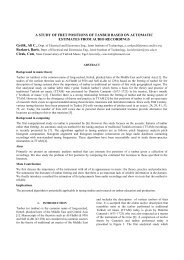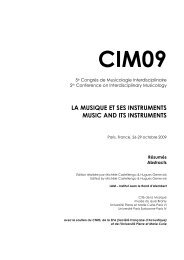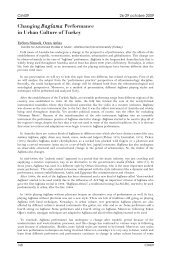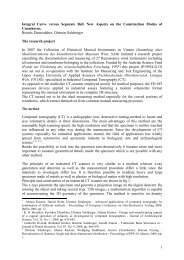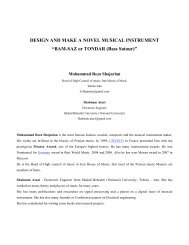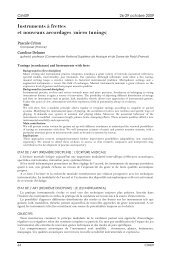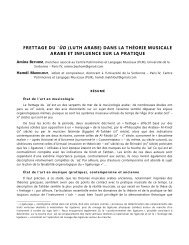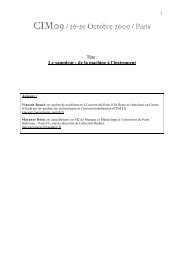L'impact des archets de violons sur la qualité sonore résultante en ...
L'impact des archets de violons sur la qualité sonore résultante en ...
L'impact des archets de violons sur la qualité sonore résultante en ...
- No tags were found...
You also want an ePaper? Increase the reach of your titles
YUMPU automatically turns print PDFs into web optimized ePapers that Google loves.
CIM09 26-29 octobre 2009<br />
L’impact <strong><strong>de</strong>s</strong> <strong>archets</strong> <strong>de</strong> <strong>violons</strong> <strong>sur</strong> <strong>la</strong> qualité <strong>sonore</strong><br />
résultante <strong>en</strong> situation <strong>de</strong> jeu musical<br />
Pascal Gail<strong>la</strong>rd, Nathalie Spanghero-Gail<strong>la</strong>rd, Marie-Pierre Berton<br />
Université <strong>de</strong> Toulouse ; UTM ; Octogone-Lordat (France)<br />
Impact of the violins bows on the resultant sound quality in situation of musical p<strong>la</strong>y<br />
Musical factory context<br />
The sound of the violin <strong>de</strong>fines itself as the result of the interaction betwe<strong>en</strong> the violinist and the violin, via the<br />
bow. This <strong>la</strong>st one repres<strong>en</strong>ts an ess<strong>en</strong>tial link for the final quality of the sound. Actually, the bowmakers conceive<br />
for five c<strong>en</strong>turies the bows which the workmanship changed to meet the needs musicians, auditors, and<br />
instrum<strong>en</strong>ts. However, the violins maker oft<strong>en</strong> have many difficulties answering the difficult question of the<br />
a<strong>de</strong>quacy betwe<strong>en</strong> their violins, the musicians, and the avai<strong>la</strong>ble bows. In particu<strong>la</strong>r, it is difficult to estimate the<br />
qualitative impact of the bow on the final sound of the violin (by putting asi<strong>de</strong> the comfort of the musician).<br />
Psychoacoustic context<br />
It is not easy "to mea<strong>sur</strong>e" the sound quality of bows (while its mechanical characteristics were studied in<br />
numerous publications). In particu<strong>la</strong>r in the case of the violin, it is ev<strong>en</strong> more difficult to attribute to the bow vs to<br />
the violin (and to the violinist) the <strong>de</strong>finitive quality of the resultant sound. The notion of sound quality, in its<br />
psychoacoustic and cognitive point of view advances the interaction, not only of the musician and its instrum<strong>en</strong>t<br />
(bow and violin), but also that of the list<strong>en</strong>er with this already complex architecture. The rec<strong>en</strong>t problem of the<br />
prototypic categorization and the adjac<strong>en</strong>t methodologies (with statistical and linguistic analyses) can help us to<br />
see more clear in these interactions there.<br />
Aims<br />
The objective is to show the impact of various bows of violins (Mil<strong>la</strong>nt, Pecatte, Morizot, and two carbons) on the<br />
final sound in a musical situation. In<strong>de</strong>ed, grounds that the result of a sound of violin is the interaction of three<br />
inseparable elem<strong>en</strong>ts in the production of this sound (the violin, the bow and the musician) we consi<strong>de</strong>red this<br />
study not only by means of a violinist (by excluding the appeal to a some machinery), but also in a musical context.<br />
The objective of the various originals musical extracts created being to use a big part of the technical possibilities<br />
of the bow.<br />
Main contribution<br />
The categorization studies were used at first for simple visual objects, th<strong>en</strong> attempted to study visual ph<strong>en</strong>om<strong>en</strong>a<br />
more complex as sc<strong>en</strong>es (Tversky and Hem<strong>en</strong>way, 1983), road <strong>en</strong>vironm<strong>en</strong>ts (Dubois, Resche-Rigon, and T<strong>en</strong>in,<br />
1997), as well as the other s<strong>en</strong>sory domains: smells (Rouby and al ., on 2002), but also a <strong>la</strong>rge variety of acoustic<br />
ph<strong>en</strong>om<strong>en</strong>a: <strong>en</strong>vironm<strong>en</strong>tal sounds (Guyot, 1996; Maffiolo, 1999; Guastavino, 2007), speech (Magn<strong>en</strong>, Billières,<br />
and Gail<strong>la</strong>rd, 2005), musical sounds (Gail<strong>la</strong>rd, 2000; Gail<strong>la</strong>rd, Castell<strong>en</strong>go, and Dubois, 2007; Morange, Fountain,<br />
and Dubois, 2007, 2009) or voice (Morange, Fountain, Vogel, and Dubois, 2005).<br />
In our study, the statistical and linguistic results show that the non-musicians have difficulty in <strong>en</strong>visaging the<br />
quality of the bow apart from the musical cont<strong>en</strong>ts (in fact, they categorize melodies). They adopt a holistic<br />
perception of the proposed extracts. On the other hand, The musicians do not realize clear c<strong>la</strong>sses. They build a<br />
differ<strong>en</strong>t perception: parametric and discriminated but not cons<strong>en</strong>sual.<br />
Implication<br />
The interaction betwe<strong>en</strong> the violins maker and the high-level instrum<strong>en</strong>talists is oft<strong>en</strong> ma<strong>de</strong> complicated by the<br />
difficulty to express and to <strong>de</strong>fine verbally their musical expectations. Our study wishes to begin a reflection on<br />
this point and to help violins maker and musicians to exchange with effici<strong>en</strong>cy by consi<strong>de</strong>ring the third<br />
interlocutor: the public.<br />
In our case, it seems that the discussion about the quality of bows and their impact on the quality of the sound of<br />
the violin cannot be held without consi<strong>de</strong>ring the totality of the musical ev<strong>en</strong>t which is there originally. In the<br />
future, it would be a question of estimating the possibility of establishing complete profiles of interactions betwe<strong>en</strong><br />
musicians, violins and bows, in a musical realizations perspective.<br />
CONTEXTE EN FACTURE INSTRUMENTALE<br />
Le son du violon se définit comme le résultat <strong>de</strong> l’interaction <strong>en</strong>tre le violoniste et le violon, via l’archet.<br />
Ce <strong>de</strong>rnier représ<strong>en</strong>te bi<strong>en</strong> un maillon ess<strong>en</strong>tiel pour <strong>la</strong> qualité finale du son. De fait, les archetiers<br />
conçoiv<strong>en</strong>t <strong>de</strong>puis cinq siècles <strong><strong>de</strong>s</strong> <strong>archets</strong> dont <strong>la</strong> facture a changé afin <strong>de</strong> répondre aux besoins <strong><strong>de</strong>s</strong><br />
musici<strong>en</strong>s, <strong><strong>de</strong>s</strong> auditeurs, et <strong><strong>de</strong>s</strong> instrum<strong>en</strong>ts. Autant les formes que les matières employées pour les<br />
fabriquer ont subi <strong>de</strong> profonds changem<strong>en</strong>ts.<br />
Cep<strong>en</strong>dant, les facteurs <strong>de</strong> <strong>violons</strong> ont souv<strong>en</strong>t beaucoup <strong>de</strong> difficultés à répondre à <strong>la</strong> difficile question <strong>de</strong><br />
l’adéquation <strong>en</strong>tre leurs <strong>violons</strong>, les musici<strong>en</strong>s, et les <strong>archets</strong> disponibles. En particulier, il est difficile<br />
d’évaluer l’impact qualitatif <strong>de</strong> l’archet <strong>sur</strong> le son final du violon (<strong>en</strong> mettant <strong>de</strong> côté le confort du musici<strong>en</strong>).<br />
82 CIM09
26-29 octobre 2009 CIM09<br />
CONTEXTE EN PSYCHOACOUSTIQUE<br />
Il est ainsi peu aisé <strong>de</strong> « me<strong>sur</strong>er » <strong>la</strong> qualité <strong>sonore</strong> <strong><strong>de</strong>s</strong> <strong>archets</strong> (alors que ses caractéristiques mécaniques<br />
ont été étudiées dans <strong>de</strong> nombreuses publications). Il n’est d’ailleurs pas forcém<strong>en</strong>t souhaitable <strong>de</strong> vouloir<br />
trouver le ou les paramètres acoustiques (me<strong>sur</strong>ables) susceptibles <strong>de</strong> représ<strong>en</strong>ter « à coup sûr » un son <strong>de</strong><br />
bonne qualité. En particulier dans le cas du violon, il est <strong>en</strong>core plus difficile d’attribuer à l’archet vs au<br />
violon (et au violoniste) <strong>la</strong> qualité définitive du son résultant. La notion <strong>de</strong> qualité <strong>sonore</strong>, dans sa vision<br />
psychoacoustique et cognitive met <strong>en</strong> avant l’interaction, non seulem<strong>en</strong>t du musici<strong>en</strong> et <strong>de</strong> son instrum<strong>en</strong>t<br />
(archet plus violon), mais aussi celle <strong>de</strong> l’auditeur avec cette architecture déjà complexe. La problématique<br />
réc<strong>en</strong>te <strong>de</strong> <strong>la</strong> catégorisation prototypique et <strong><strong>de</strong>s</strong> méthodologies att<strong>en</strong>antes (avec <strong><strong>de</strong>s</strong> analyses statistiques et<br />
linguistiques) peut nous ai<strong>de</strong>r à y voir pus c<strong>la</strong>ir dans ces interactions.<br />
OBJECTIFS<br />
L’objectif est <strong>de</strong> montrer l’impact <strong>de</strong> différ<strong>en</strong>ts <strong>archets</strong> <strong>de</strong> <strong>violons</strong> (Mil<strong>la</strong>nt, Pecatte, Morizot, et <strong>de</strong>ux<br />
carbones) <strong>sur</strong> le son final dans une situation musicale. En effet, considérant que le résultat d’un son <strong>de</strong><br />
violon est l’interaction <strong>de</strong> trois élém<strong>en</strong>ts indissociables dans <strong>la</strong> production <strong>de</strong> ce son (le violon, l’archet et le<br />
musici<strong>en</strong>) nous avons considéré cette étu<strong>de</strong> non seulem<strong>en</strong>t avec l’ai<strong>de</strong> d’un violoniste (<strong>en</strong> excluant le recours<br />
à une quelconque machinerie), mais aussi dans un contexte musical. L’objectif <strong><strong>de</strong>s</strong> différ<strong>en</strong>ts extraits<br />
musicaux créés pour l’occasion étant d’utiliser une gran<strong>de</strong> partie <strong><strong>de</strong>s</strong> possibilités techniques du violon<br />
mettant particulièrem<strong>en</strong>t <strong>en</strong> jeu l’archet.<br />
CONTRIBUTIONS PRINCIPALES<br />
Les étu<strong><strong>de</strong>s</strong> <strong>de</strong> catégorisation ont d’abord été utilisées pour <strong>de</strong> simples objets visuels, puis se sont attachées<br />
à étudier <strong><strong>de</strong>s</strong> phénomènes visuels plus complexes comme <strong><strong>de</strong>s</strong> scènes (Tversky & Hem<strong>en</strong>way, 1983), <strong><strong>de</strong>s</strong><br />
<strong>en</strong>vironnem<strong>en</strong>ts routiers (Dubois, Resche-Rigon, & T<strong>en</strong>in, 1997), ainsi que d’autres domaines s<strong>en</strong>soriels :<br />
<strong><strong>de</strong>s</strong> o<strong>de</strong>urs (Rouby et al., 2002), mais aussi une gran<strong>de</strong> diversité <strong>de</strong> phénomènes acoustiques : les sons<br />
<strong>en</strong>vironnem<strong>en</strong>taux (Guyot, 1996 ; Maffiolo, 1999 ; Guastavino, 2007), <strong>la</strong> parole (Magn<strong>en</strong>, Billières, &<br />
Gail<strong>la</strong>rd, 2005), les sons musicaux (Gail<strong>la</strong>rd, 2000 ; Gail<strong>la</strong>rd, Castell<strong>en</strong>go, & Dubois, 2007 ; Morange,<br />
Fontaine, & Dubois, 2007, 2009) ou <strong>en</strong>core <strong>la</strong> voix (Morange, Fontaine, Vogel, & Dubois, 2005). Dans notre<br />
étu<strong>de</strong>, les résultats statistiques et linguistiques montr<strong>en</strong>t que les non-musici<strong>en</strong>s ont du mal à <strong>en</strong>visager <strong>la</strong><br />
qualité <strong>de</strong> l’archet <strong>en</strong> <strong>de</strong>hors du cont<strong>en</strong>u musical (<strong>en</strong> fait, ils catégoris<strong>en</strong>t les mélodies). Ils adopt<strong>en</strong>t une<br />
perception holistique <strong><strong>de</strong>s</strong> extraits proposés. En revanche, les musici<strong>en</strong>s sont beaucoup plus partagés <strong>en</strong> ne<br />
réalisant pas <strong>de</strong> c<strong>la</strong>sses c<strong>la</strong>ires. Ils construis<strong>en</strong>t une perception différ<strong>en</strong>te : paramétrique et discriminante<br />
mais non cons<strong>en</strong>suelle.<br />
IMPLICATIONS<br />
L’interaction <strong>en</strong>tre les facteurs <strong>de</strong> <strong>violons</strong> et les instrum<strong>en</strong>tistes <strong>de</strong> haut niveau est souv<strong>en</strong>t r<strong>en</strong>due<br />
compliquée justem<strong>en</strong>t par <strong>la</strong> difficulté <strong><strong>de</strong>s</strong> uns et <strong><strong>de</strong>s</strong> autres à exprimer et à définir verbalem<strong>en</strong>t leurs<br />
att<strong>en</strong>tes musicales. Notre étu<strong>de</strong> souhaite débuter une réflexion <strong>sur</strong> ce point et ai<strong>de</strong>r les facteurs et les<br />
musici<strong>en</strong>s à échanger avec efficacité <strong>en</strong> considérant le troisième interlocuteur : le public. Dans notre cas, il<br />
semble que <strong>la</strong> discussion <strong>sur</strong> <strong>la</strong> qualité <strong><strong>de</strong>s</strong> <strong>archets</strong> et leur impact <strong>sur</strong> <strong>la</strong> qualité du son du violon ne peut pas<br />
se t<strong>en</strong>ir sans considérer <strong>la</strong> totalité <strong>de</strong> l'événem<strong>en</strong>t musical qui <strong>en</strong> est à l’origine. A terme, il s’agirait<br />
d’évaluer <strong>la</strong> possibilité d’établir <strong><strong>de</strong>s</strong> profils complets d’interactions <strong>en</strong>tre musici<strong>en</strong>s, <strong>violons</strong> et <strong>archets</strong>, dans<br />
une perspective <strong>de</strong> réalisations musicales.<br />
RÉFÉRENCES<br />
Carlsson, P., & Tinnst<strong>en</strong>, M. (2003). Numerical optimization of violin bows with varying <strong>de</strong>nsities of the wood<br />
material. Paper pres<strong>en</strong>ted at the Stockholm Music Acoustics Confer<strong>en</strong>ce 2003, Stockholm.<br />
Dauchez, N., Génevaux, J.-M., & Brémaud, I. (2006, 24-27 avril 2006). Qualité <strong><strong>de</strong>s</strong> <strong>archets</strong> <strong>de</strong> <strong>violons</strong> et instabilité<br />
<strong>de</strong> type f<strong>la</strong>mbem<strong>en</strong>t. 8e Congrès Français d'Acoustique, Tours.<br />
Dubois, D., Resche-Rigon, P., & T<strong>en</strong>in, A., 1997, Des couleurs et <strong><strong>de</strong>s</strong> formes : catégories perceptives ou<br />
construction cognitives. In D. Dubois (Ed.), Catégories et cognition, Paris, Kimé, 7-40.<br />
Gail<strong>la</strong>rd, P., 2000, Etu<strong>de</strong> <strong>de</strong> <strong>la</strong> perception <strong><strong>de</strong>s</strong> transitoires d'attaque <strong><strong>de</strong>s</strong> sons <strong>de</strong> steeldrums : particu<strong>la</strong>rités<br />
acoustiques, transformation par synthèse et catégorisation. Musique, Acoustique Musicale et Perception,<br />
Université <strong>de</strong> Toulouse II - Le Mirail, Toulouse.<br />
Gail<strong>la</strong>rd, P., Castell<strong>en</strong>go, M., & Dubois, D., 2007, Variabilité temporelle dans <strong>la</strong> perception <strong><strong>de</strong>s</strong> transitoires<br />
d’attaque <strong>de</strong> sons percussifs. Cahiers <strong>de</strong> <strong>la</strong> SQRM (Société québécoise <strong>de</strong> recherche <strong>en</strong> musique), 9(1-2),<br />
39-48.<br />
Guastavino, C., 2007, Categorization of <strong>en</strong>vironm<strong>en</strong>tal sounds. Canadian Journal of Experim<strong>en</strong>tal Psychology,<br />
61(1), 54-63.<br />
Guyot, F., 1996, Etu<strong>de</strong> <strong>de</strong> <strong>la</strong> perception <strong>sonore</strong> <strong>en</strong> termes <strong>de</strong> reconnaissance et d'appréciation qualitative : une<br />
approche par <strong>la</strong> catégorisation. Psychoacoustique, Université du Maine, Paris.<br />
CIM09 83
CIM09 26-29 octobre 2009<br />
Holm, J.-M. (2004). Virtual Violin in the Digital Domain. Physical Mo<strong>de</strong>ling and Mo<strong>de</strong>l-based Sound Synthesis of<br />
Violin and its Interactive Application in Virtual Environm<strong>en</strong>t. JYVÄSKYLÄ.<br />
Maffiolo, V., 1999, Caractérisation sémantique et acoustique <strong>de</strong> <strong>la</strong> qualité <strong>sonore</strong> <strong>de</strong> l'<strong>en</strong>vironnem<strong>en</strong>t urbain.<br />
Acoustique, Université du Maine, Paris.<br />
Magn<strong>en</strong>, C., Billières, M., & Gail<strong>la</strong>rd, P., 2005, Surdité phonologique et catégorisation. Perception <strong><strong>de</strong>s</strong> voyelles<br />
françaises par les hispanophones. Revue PArole(33), 9-34.<br />
Morange, S., Fontaine, J.-M., & Dubois, D. ,2007, 15-17 august 2007, Voices of Caruso : Cognitive evaluation and<br />
acoustic analysis of reedited editions. Paper pres<strong>en</strong>ted at the Third Confer<strong>en</strong>ce on Interdisciplinary<br />
Musicology (CIM07), Tallinn, Estonia.<br />
Morange, S., Fontaine, J.-M., & Dubois, D., 2009, Perception of Recording Singing Voice Quality and Expertise :<br />
cognitive linguistics and acoustics approaches. Journal of Voice, Elsevier, the Voice Fondation & Intern.<br />
Ass. of Phono<strong>sur</strong>gery.<br />
Morange, S., Fontaine, J.-M., Vogel, C., & Dubois, D., 2005, 7 octobre 2005, Appart<strong>en</strong>ances catégorielles d'un<br />
objet complexe ; <strong>la</strong> voix : approches linguistique et psycho-cognitives. Paper pres<strong>en</strong>ted at the 3e Journée<br />
du S<strong>en</strong>solier - Catégorisation et catégories : <strong><strong>de</strong>s</strong> théories cognitives aux pratiques <strong>en</strong> évaluation<br />
s<strong>en</strong>sorielle, Ivry.<br />
Rouby, C., Schaal, B., Dubois, D., Gervais, R., & Holley, A., 2002, Olfaction, Taste and Cognition, Cambridge /<br />
New-York, Cambridge University Press.<br />
Tversky, B., & Hem<strong>en</strong>way, K., 1983, Categories of sc<strong>en</strong>es. Cognitive Psychology, 15, 121-149.<br />
Wegst, U. G. K., & Ashby, M. F. (1996). Alternative woods for violin bows. Newsletter of the British Violin Making<br />
Association, 5, 7-14.<br />
AUTEURS<br />
Pascal Gail<strong>la</strong>rd<br />
pascal.gail<strong>la</strong>rd@univ-tlse2.fr<br />
Musici<strong>en</strong>, Psychoacoustici<strong>en</strong> ; Maître <strong>de</strong> confér<strong>en</strong>ces<br />
Université <strong>de</strong> Toulouse ; UTM ; Octogone-Lordat<br />
5 allées Antonio Machado<br />
31058, Toulouse Ce<strong>de</strong>x 1 — France<br />
Nathalie Spanghero-Gail<strong>la</strong>rd<br />
nathalie.spanghero@univ-tlse2.fr<br />
Linguiste ; Maître <strong>de</strong> confér<strong>en</strong>ces — HDR<br />
Université <strong>de</strong> Toulouse ; UTM ; Octogone-Lordat<br />
5 allées Antonio Machado<br />
31058, Toulouse Ce<strong>de</strong>x 1 — France<br />
Marie-Pierre Berton<br />
bertonmariepierre@gmail.com<br />
Violoniste<br />
Université <strong>de</strong> Toulouse ; UTM ; Octogone-Lordat<br />
5 allées Antonio Machado<br />
31058, Toulouse Ce<strong>de</strong>x 1 — France<br />
Étu<strong>de</strong> réalisée avec l’ai<strong>de</strong> <strong>de</strong> MM. Pierre-Yves Dalle-Carbonare, Luthier à Toulouse et K<strong>la</strong>us Mulhberger, CRR <strong>de</strong> Toulouse<br />
84 CIM09


